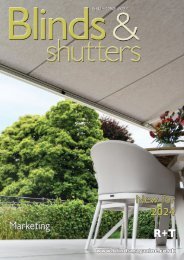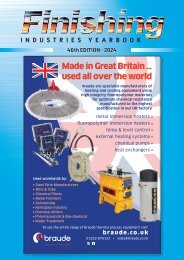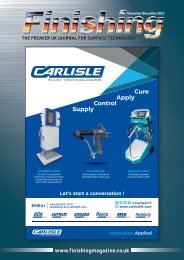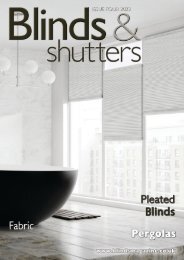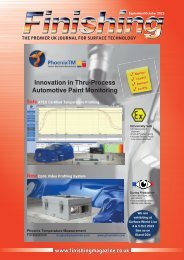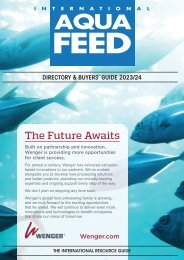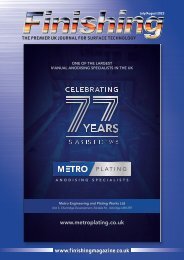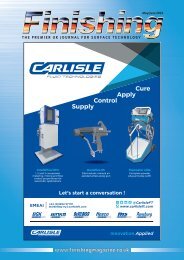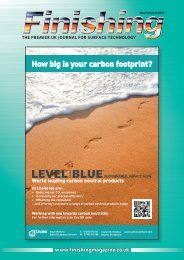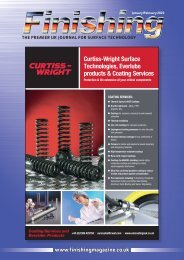Finishing - July-August 2022
This issue has the winners of the galvanizing industry awards, plus an update on the new Carlisle innovation centre. There is also a report from the BCF conference and a review of the Qualicoat conference with took place in London a few weeks ago. It’s great to see that in person events are taking place and that people are excited to go. Long may this continue!
This issue has the winners of the galvanizing industry awards, plus an update on the new Carlisle innovation centre. There is also a report from the BCF conference and a review of the Qualicoat conference with took place in London a few weeks ago. It’s great to see that in person events are taking place and that people are excited to go. Long may this continue!
You also want an ePaper? Increase the reach of your titles
YUMPU automatically turns print PDFs into web optimized ePapers that Google loves.
26 PROFILE<br />
12 step<br />
programme<br />
Taking it back to basics, at CWST we are<br />
experts in metal surface finishing<br />
treatment processes. But what does this<br />
really mean?<br />
Simply, that we have vast knowledge in a<br />
range of industrial processes that alter the<br />
surface of metal to achieve a certain property,<br />
for example, to improve appearance,<br />
adhesion, corrosion resistance, hardness and<br />
much more. These can be categorised by how<br />
they affect the subject, either<br />
removing/reshaping the finishing, or<br />
adding/altering the finishing.<br />
At CWST we offer 12 key metal surface<br />
finishing treatment processes, each increasing<br />
performance and life of metal components by<br />
protecting against premature failure, due to<br />
fatigue, corrosion, stress, fretting, friction and<br />
galling, as well as support against<br />
environmental and thermal variation.<br />
Our high-performance metal surface<br />
finishing treatments include the following.<br />
Controlled Shot Peening<br />
Tensile stresses induced during welding,<br />
grinding, machining and heat treatment are<br />
replaced with beneficial compressive stresses<br />
proven to prevent fatigue and stress corrosion<br />
cracking.<br />
This cold working process is applied using<br />
spherical media known as ‘shot’, as each piece<br />
hits the surface it creates an indentation where<br />
the surface will attempt to yield but is<br />
restrained by the substrate material. This in<br />
turn causes the material to compress, creating<br />
added stress – making the surface crack<br />
resistant and removes any prior<br />
manufacturing tensile stress.<br />
Shot Peen Forming<br />
Creates curvature in aircraft wing skins to<br />
enhance lift and efficiency and to protect<br />
against fatigue. Also used to correct the<br />
distortion of components following<br />
manufacturing.<br />
Within this process, material is fired at the<br />
surface, creating indentations causing the<br />
material to elastically stretch, however it is<br />
restrained by the substrate. This causes the<br />
surface to arc towards the peened side,<br />
resulting in curvature. This method can induce<br />
stress to greater depths, with a tighter radius<br />
of curvature as well as being able to be<br />
performed on thicker materials.<br />
Laser Shock Peening<br />
Laser peening induces compressive stress<br />
with precision accuracy into key areas of a<br />
component up to 5 to 10 times deeper than<br />
other conventional cold working techniques.<br />
Laser shock peening uses an output beam<br />
at 25 joules at 18 nanoseconds from a glass<br />
laser, a thin stream of water is made to flow<br />
across the surface and the laser transparently<br />
passes through the water, and a pulse is<br />
absorbed on the metal surface. The rise in<br />
pressure creates a shock wave that penetrates<br />
into the metal, straining the surface layer.<br />
C.A.S.E. Isotropic <strong>Finishing</strong><br />
Super finishing<br />
Removes surface asperities to create a<br />
mirror like finish, reducing macro and micropitting,<br />
oil temperature and noise whilst<br />
promoting lubricant retention.<br />
This process uses controlled shot peening,<br />
followed by chemical surface superfinishing.<br />
This removes any metal asperities, retaining<br />
valleys for optimum oil retention, reducing<br />
surface friction and operating temperatures.<br />
Thermal Spray Coatings<br />
Wear resistant and barrier coatings such as<br />
HVOF, arc and flame spray, protecting against<br />
<strong>Finishing</strong> - <strong>July</strong>/<strong>August</strong> <strong>2022</strong><br />
continues on p28




